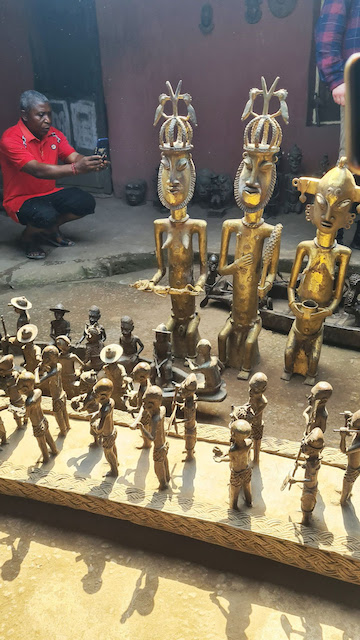Stefan Parsch, dpa l Thursday, April 6, 2023
BERLIN – Many of the Benin Bronzes were made from brass mined thousands of kilometres away in Germany’s Rhineland, between the cities of Cologne and Aachen, research has revealed.
The Benin Bronzes are a group of several thousand ornate metal plaques and sculptures which decorated the palace in the Kingdom of Benin, now Edo State in present-day Nigeria.
They were taken by colonial forces and placed in collections around the world. A new study published in the specialist peer-reviewed journal PLOS ONE showed that many of the priceless artworks were created using melted-down brass manilla bracelets from western Germany.
Manillas were used as a currency across West Africa from the 15th century onwards. They were a common means of payment for slaves, and many of the bracelets have been found in shipwrecks that had been carrying them.
The scientists involved in the study looked at 67 manillas, dated to the 16th to 19th centuries, from five shipwrecks. The wrecks were located in African, European and American waters of the Atlantic.
The study – led by Tobias Skowronek from the Technical University of Georg Agricola in Bochum, Germany – examined the lead isotopes in the manillas to trace their origins back to Germany.
Despite the name Benin Bronzes, most of the artworks are made of brass, which contains mainly copper and zinc, but often also lead, tin and other elements.
That manillas were repurposed to form the bronzes has long been known. But that many of these bracelets were made from brass mined around the Cologne area is seen as a major discovery.
A contract between the German mercantile and banking dynasty Fugger and the Portuguese king from 1548 for the delivery of manillas corroborates the scientific analysis.
After being produced in the Rhineland, the manillas were transported more than 6,300 kilometres to the Kingdom of Benin, Skowronek said.
Since manillas did not play a role in European trade, they were produced in Europe almost exclusively for trade with Africa. From the 15th century onwards, it was mainly the Portuguese who traded with West African peoples, later joined by other colonial powers.
Stefan Simon, director of the Rathgen Research Laboratory of the National Museums in Berlin, said the study is a big step towards clarifying the question of how the raw material used in the famed sculptures came to Benin.
Like elsewhere in Europe, many German museums and university collections have long featured Benin Bronzes.
German authorities have been increasingly heeding the Nigerian government’s demand for the return of the stolen artworks.
In a landmark ceremony in Abuja in December, Germany’s foreign and culture ministers returned 20 of the precious artefacts that had been held in five German museums. Most of the bronzes were looted by a British military expedition in 1897.
